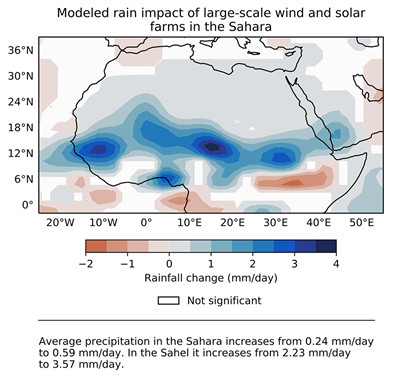Wind and solar farms are known to have local effects on heat, humidity and other factors that may be beneficial -- or detrimental -- to the regions in which they are situated. A new climate-modeling study finds that a massive wind and solar installation in the Sahara Desert and neighboring Sahel would increase local temperature, precipitation and vegetation. Overall, the researchers report, the effects would likely benefit the region. The study, reported in the journal Science, is among the first to model the climate effects of wind and solar installations while taking into account how vegetation responds to changes in heat and precipitation, said lead author Yan Li, a postdoctoral researcher in natural resources and environmental sciences at the University of Illinois.  Large-scale wind and solar installations in the Sahara would increase precipitation, a new study finds. Credit: Map by Eviatar Bach CC BY 4.0 Source from: 1. https://phys.org/news/2018-09-large-solar-farms-sahara-vegetation.html#:~:text=Large%20wind%20and%20solar%20farms%20in%20the%20Sahara,known%20to%20have%20local%20effects%20on%20heat%2C%20 2. Li Y., el al. "Climate model shows large-scale wind and solar farms in the Sahara increase rain and vegetation," Science (2018). https://www.science.org/doi/full/10.1126/science.aar5629 |



